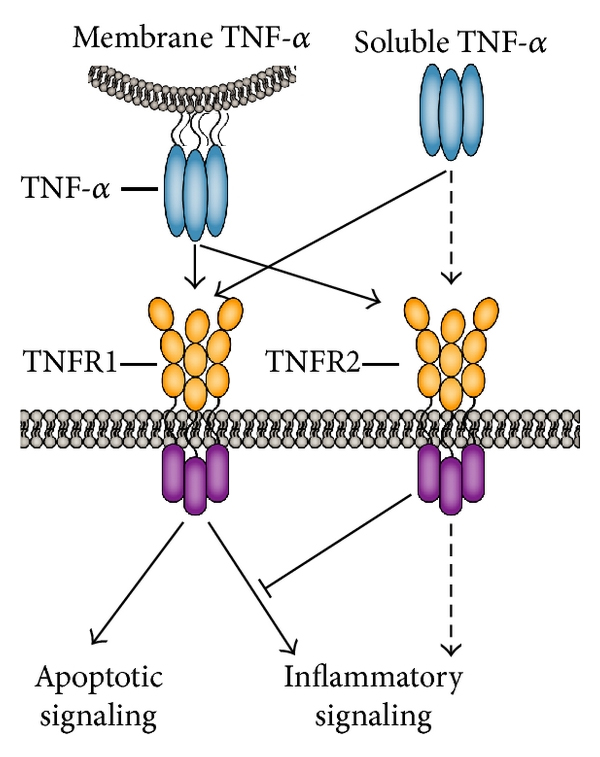This animated 3D structure was determined by X-ray analysis of crytallized complexes between the homotrimeric recombinant human TRAIL cytokine, or Tumor Necrosis Factor (TNF)-Related Apoptosis Inducing Ligand, and three bound recombinant Death Receptor 5 (DR5) extracellular domain fragments of this single-subunit membrane protein.
The TRAIL cytokine is a semi-homotrimeric structure created from a type 2 membrane-integrated precursor protein that transverses the cell membrane six times, like that suggested for membrane-integrated TNFα in the illustration below. Proteolytic cleavage of the membranee-integrated precursor frees the soluble, bioactive TRAIL cytokine.
TRAIL is produced and secreted by most normal cells whereas DR5 is rarely if ever expressed on normal cells but is expressed on a subset of tumor cells. Because the extracellular domains of up to 3 membrane-integrated DR5 receptors can bind a single TRAIL cytokine, the physical clustering of 2 or 3 DR5 receptors greatly enhances the intracellular signaling events triggered by the intracellular domains of these receptors, which typically induce caspase mediated programmed cell death or apoptosis.
- Because the membrane-integrated TRAIL polypeptide transverses the cell membrane six times, three polypeptide loops are created that extend extracellularly from the cell membrane. When the soluable TRAIL cytokine is released by proteolysis, the N-terminal and C-terminal AA ends of looped fragments are found in the same general physical proximity, which can be observed by clicking on the checkbox to view the membrane distal orientaion of the bound DR5 subunits.
- In contrast, the N-terminal and C-terminal AA residues of each extracellular DR5 subunit fragment bound to TRAIL are found at opposite ends of the these subunits, which traverse the cell membrane only once. Their C-terminal ends are closest to the membrane, which can be observed by clicking on the membrane proximal orientation of the bound DR5 subunit.
TRAIL and its DR5 receptor represent just one pairing in the TNF super family of nearly 30 homologous cytokines and their (moslly) membrane-integrated receptors. As illustrated in the image below, the TNF-α cytokine exists in both membrane-integrated and soluble forms, which can potentially interact with two receptors - TNFR1 and TNFR2 - in order to elicit the subsequent cellular responses.

https://static-01.hindawi.com/articles/isrn/volume-2013/371854/figures/371854.fig.002a.jpg
TNF was the first member of this family to be characterized, beginning almost 60 years ago when its role in chronic wasting disease and spontaeous tumor cell killing started to be elucidated. Since then, many other homologous pairings in this super family have been discovered and found to play diverse roles in many important physiological functions and immunological responses.